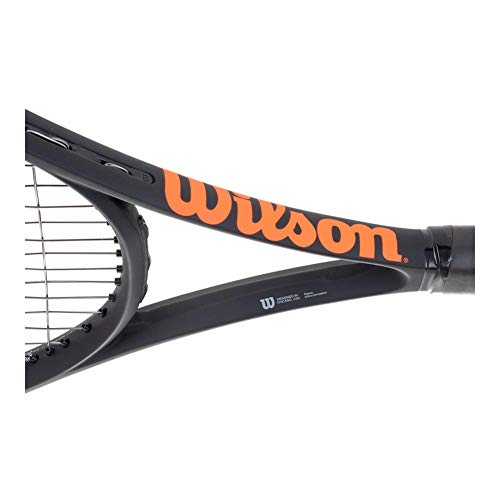Perhaps one of the most noteworthy versatile tennis racquets on the market today is the Wilson Clash 100.
A racquet built for intermediate to advanced tennis players that will bend with your unique swing style due to its Freeflex technology.
After 3 years of development, Wilson unveiled what would be one of the most innovative racquets on the market in 2019.
Prices pulled from the Amazon Product Advertising API on:
Product prices and availability are accurate as of the date/time indicated and are subject to change. Any price and availability information displayed on [relevant Amazon Site(s), as applicable] at the time of purchase will apply to the purchase of this product.
This new design caters to the modern player with an intermediate to advanced skill level. This racquet is especially beneficial for athletes that are looking to optimize their control while they play.
Freeflex technology utilizes Wilson’s proprietary carbon mapping which allows the frame to flex, supporting optimal accuracy and enhancing power in every swing.
Don’t think for a minute that flexible means you’ll be less accurate.
What Exactly is FreeFlex?

To fully appreciate the Wilson Clash 100, you must understand the revolutionary technology built right into this modern racquet.
FreeFlex allows the Clash 100 to be the world’s first racquet that bends intentionally, both horizontally and vertically. The ability to bend and flex doesn’t compromise accuracy with the torsional stability feature.
The Wilson Clash 100 tennis racquet measures in at being 115% more flexible but also holds the ball 23% longer than the average leading racquet, per Wilson’s internal testing center.
In this Wilson Clash 100 review, I’ll walk you through its features, pros, cons, a few things to consider before buying, and my final thoughts.
Wilson Clash 100 Tennis Racquet Specifications
Comparing the Wilson Clash 100 strictly from a specification standpoint just further reinforces this racquet’s position as a well-balanced goliath in the tennis racquet industry.
1. Headsize
100 sq inches seems to be the pioneering size for a modern racquet like the Clash 100. Head size of that particular size typically produces more power and spin.
2. String Pattern
The Wilson Clash 100 has a string pattern of 16×19, which is one of the most common open string patterns.
Having an open string pattern allows you to hit with more power and depth. Those open spaces really hug the ball every time the strings make contact.
3. Weight
If Goldilocks could find the perfect fit for a tennis racquet she would gladly settle for the Wilson Clash 100.
This racquet comes in at 295g, placing it just above the light-weight category for racquets. The weight optimizes your ability to control and maneuver your swing without sacrificing power.
4. Balance
The Wilson Clash 100 has an unstrung balance of 31CM/10 Pts HL, making it a head light type of racquet.
Being a head light racquet makes it a smooth operator in terms of being able to maneuver and have ultimate control without being top-heavy. It’s just another added testament to the versatility of this racquet.
5. Length
Coming in at 27 inches the Wilson Clash 100 falls within industry standards. Any longer of a tennis racquet may cause stability and control issues.
6. Look and Feel
Taking nods from the iconic Wilson color palette this racquet features an attractive matte finish with flashes of gray, red, and black.
A classic style with a modern twist that will fit a wide variety of personalities on the court.
Why I Love the Wilson Clash 100
At the end of the day if you are looking for a tennis racquet that is going to help you optimize control, stability, speed, and power, then the Wilson Clash 100 might be the perfect fit.
Wilson Clash 100 tennis racquet has won an Editor’s Choice Award for the best new racquet innovation.
Finally, for peace of mind, you’ll be happy to know that this product includes a warranty.
Wilson provides a one-year limited manufacturer’s warranty on their racquets from the original date of purchase.
Just keep in mind that the warranty is not extended to purchases made via a third-party reseller.
Wilson Clash 100 Review: Pros and Cons
Pros
- FreeFlex
- Head light
- Maneuverable
- Control
- Spin
- Ball pocketing
- Balance
Cons
- Designed for more intermediate and advanced players.
- Cannot customize paint from the manufacturer.
What Should You Know Before Buying Wilson Clash 100 Racquet?
Your racquet becomes an extension of you out on the tennis court, so it’s no wonder many tennis enthusiasts do their homework before they commit to buying a new racquet.
Some key factors to note are:
1. Skill Level: When shopping for a racquet you should take time to analyze your skill level. This will help you determine what type of racquet will most complement your play style.
Defining your objectives is important too, seeing if you value power over control, or if you need something in between for balance.
2. Physical Size: Determining if a longer or shorter racquet will fit your body type better.
3. To String or Not to String: The majority of advanced-level tennis players prefer to get their racquets custom strung rather than ordering them pre-strung at the manufacturer.
Often times the manufacturer will offer instructions on stringing your racquet.
Prices pulled from the Amazon Product Advertising API on:
Product prices and availability are accurate as of the date/time indicated and are subject to change. Any price and availability information displayed on [relevant Amazon Site(s), as applicable] at the time of purchase will apply to the purchase of this product.
The Anatomy of a Tennis Racquet
Diving a little deeper into discussing the Wilson Clash 100 requires dissecting the anatomy of a racquet. There are a few main components to take note of:
1. Head
The head is the top large area on the racquet where the strings are located and where the ball will make contact when you take a swing.
2. Beam
The thickness of a racquet’s head is considered the beam. The beam can change the anatomy of your racquet by adding weight and may have an impact on the overall feel.
3. Strings
The heart of your racquet is most definitely the strings. These “little” pieces have a massive impact on how much power and control you have over your swing.
There are two different types of string patterns, open and dense. Open patterns tend to give you more power and spin. Dense patterns have a focus on control and offer a lower shot trajectory.
4. Grip
The part of the racquet where you hold and place your hand is known as the grip.
The grip can be several different sizes, and it’s crucial to ensure you select the measurement that is most appropriate for your hand.
If you are in between grip sizes, it’s best to go with a smaller grip that you can add overgrip to later.
In Conclusion
After critiquing the Wilson Clash 100 review, it’s clear to say that the pros outweigh the cons.
While this pioneering racquet isn’t going to supply explosive power, it will enhance the power you bring to the game and give you ultimate control.
Check out more Wilson Tennis Racquets here.

My name is Reagen and I started AllTennisGear (earlier AllTennisShoes) as a way to share my humble experience and help new Tennis players. Thank you for spending a few minutes of your day here and know that your feedback is always welcome.






